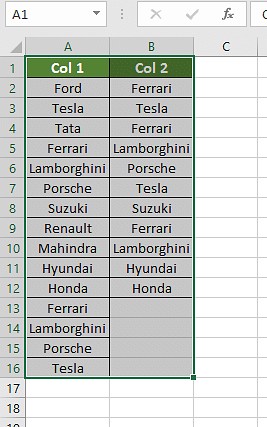Comparing data across multiple columns in Excel is a common task in data analysis. Doing this manually can be time-consuming and error-prone, especially with large datasets. Fortunately, Excel offers several efficient methods to compare matching data quickly and accurately. This article explores various techniques, including conditional formatting, formulas, and functions, to help you master data comparison in Excel.
Comparing Data with Conditional Formatting
Conditional formatting allows you to visually highlight cells based on specific criteria, making it easy to identify matches and differences. To compare two columns:
- Select the Data: Highlight the columns you want to compare.
- Apply Conditional Formatting: Go to “Home” -> “Conditional Formatting” -> “Highlight Cells Rules” -> “Duplicate Values”.
- Choose Formatting: Select a formatting style to highlight matching or unique values. “Duplicate” highlights matching data; “Unique” highlights differing data.
Comparing Data Using Formulas and Functions
Excel provides several formulas and functions for precise data comparison:
1. Equals Operator (=)
The simplest method is using the equals sign (=) to compare individual cells. In a new column, enter a formula like =A1=B1. This returns TRUE if the cells match and FALSE if they don’t.
2. IF Function
Combine the equals operator with the IF function for customized results. For example, =IF(A1=B1,"Match","Mismatch") displays “Match” for identical cells and “Mismatch” for different ones. You can tailor the messages to your specific needs.
3. EXACT Function
The EXACT function is case-sensitive, returning TRUE only if the cell contents are identical, including capitalization. Use =EXACT(A1,B1) for case-sensitive comparisons.
4. VLOOKUP Function
VLOOKUP searches for a specific value in the first column of a range and returns a value in the same row from a specified column. This is useful for finding matches across larger datasets and extracting corresponding information. The formula structure is: =VLOOKUP(lookup_value, table_array, col_index_num, [range_lookup]). Setting range_lookup to FALSE ensures exact matches.
Choosing the Right Method
- Conditional Formatting: Best for quick visual identification of matches and differences.
- Equals Operator: Suitable for simple cell-by-cell comparisons.
- IF Function: Ideal for customized results based on comparison outcomes.
- EXACT Function: Essential for case-sensitive comparisons.
- VLOOKUP Function: Powerful for searching and extracting matching data from large tables.
Conclusion
Excel offers a versatile toolkit for comparing matching data. By understanding and applying these techniques, you can efficiently analyze data, identify discrepancies, and extract valuable insights. Selecting the appropriate method depends on your specific needs and the complexity of your data. Mastering these tools will significantly enhance your data analysis capabilities in Excel.

